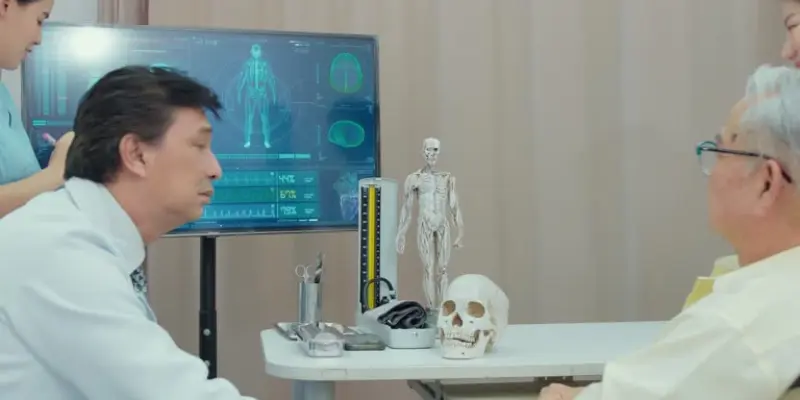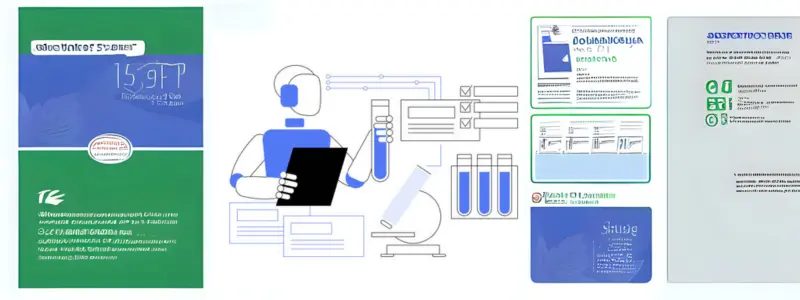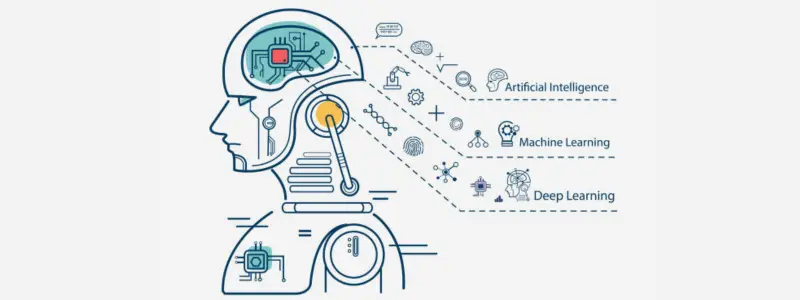How AI Helps in Cancer Diagnosis – A Simple Guide
Published: 16 May 2025
Did you know that over 18 million people worldwide were diagnosed with cancer in a single year? That’s a huge number. Early diagnosis can save lives but many people still get diagnosed too late. Why? Because cancer can be hard to find in its early stages.
Now, imagine a smart computer that helps doctors spot cancer faster and more accurately. That’s what AI (Artificial Intelligence) is doing. It’s like giving doctors a powerful new tool to catch cancer early.
In this post, I will explain how AI works in cancer diagnosis, why it matters and how it’s changing the way doctors treat patients. Ready to explore how this smart tech is helping to fight cancer? Let’s get started.

What is AI in Healthcare?
Let’s keep it simple. AI stands for Artificial Intelligence. It’s a type of computer program that can “think” and learn from data just like humans do.
In healthcare, AI works like a super-smart helper. It studies large amounts of health data and finds patterns that doctors might miss. This can include X-rays, test results or even notes from your medical history.
Example
Think of AI like a pair of super-sharp eyes. A doctor might look at a scan and see nothing unusual. But AI might spot a tiny spot or change that could mean something serious, like cancer. It’s like having a second opinion, one that’s really fast and really good at spotting patterns.
Why It Matters
AI is not going to replace your doctor. It’s here to help doctors make better decisions. When doctors and AI work together, they can find problems earlier, treat them faster and give patients better care.
How AI Diagnoses Cancer
AI helps doctors to find cancer by studying different kinds of medical information. It looks at images, lab tests and patient records to spot anything unusual. Let’s take a closer look at how it works.
A. Using Medical Images to Spot Cancer
Medical images like X-rays, CT scans, MRI scans and mammograms are key tools doctors use to find cancer. But going through many images each day can be hard and even trained eyes can miss small signs.
AI tools are trained using thousands (sometimes millions) of these images. They learn what cancer looks like and get better over time at spotting the tiny changes that might mean something is wrong.
Real-Life Example
Google Health developed an AI tool that helps in detecting breast cancer from mammograms. In some cases, the AI was even more accurate than doctors. It spotted signs that were very easy to miss.
How It Helps:
- Finds tumors early, even tiny ones
- Reduces human errors
- Helps in busy hospitals where doctors have less time
B. Analyzing Lab Reports and Test Results
Besides images, AI can also study medical reports like blood tests, biopsy reports and even genetic data. These tests can be full of small details that are easy to overlook.
AI looks for patterns in test results that match early signs of cancer. It can flag abnormal values, compare them to past records and suggest when something needs attention.

Real-Life Example
At some hospitals, AI is used to read pathology slides which are thin slices of tissue under a microscope. It checks for cancer cells and highlights the areas a doctor should review. This saves time and ensures nothing is missed.
How It Helps:
- Speeds up diagnosis
- Helps pathologists to focus on high-risk areas
- Reduces delays in reporting test results
C. Detecting Cancer in Its Early Stages
The earlier cancer is found, the better the chance of successful treatment. AI tools are helping doctors to catch cancer before symptoms even appear.
Some AI apps can scan things like skin moles, cough sounds, or breathing patterns. These tools can give early warnings that something might be wrong.
Real-Life Example
An AI app called SkinVision lets people take a picture of a mole with their phone. The app checks the mole and tells users if it looks risky and if they should see a doctor.
How It Helps:
- Encourages early doctor visits
- Helps people in rural areas where specialists aren’t nearby
- Gives peace of mind to patients waiting for results
How AI Predicts Tumors’ Molecular Profiles
Every tumor is different. Some grow fast. Others grow slowly. What makes them act this way? The answer is hidden inside their molecular profile, the unique mix of genes, proteins and mutations in the cancer cells.
Doctors use this information to decide which treatment will work best. But finding that profile takes time and special lab tests. That’s where AI steps in to help.
What Is a Molecular Profile?
A molecular profile is like a blueprint of a tumor. It shows:
- What genes are active
- If there are any mutations
- What proteins the tumor makes
This helps doctors understand:
- How aggressive the cancer is
- Which drugs it will respond to
- What the patient’s outcome might be

How AI Helps Predict the Profile
AI uses data from:
- Medical images (like scans)
- Pathology slides (tissue samples)
- Genomic tests (gene-level data)
By studying patterns in this data, AI can predict the tumor’s behavior without always needing extra tests.
Real-Life Example
A study published in Nature Medicine showed that an AI model could look at lung cancer tissue slides and predict gene mutations like EGFR or KRAS just from the image. These are important genes that affect treatment decisions.
This means doctors can:
- Get faster results
- Avoid extra lab work
- Make better treatment plans sooner
How It Works in Simple Steps:
- AI looks at a digital image of a tumor (from a microscope or scan).
- It matches visual patterns with known gene activity.
- It gives doctors a report saying, “This tumor may have these mutations.”
- The doctor can double-check with a genetic test if needed.
AI Algorithms Used in Cancer Diagnosis
AI tools don’t just run on magic, they use special algorithms (step-by-step instructions) to do their job. These algorithms help the computer learn from medical data, spot patterns and make predictions.
Let’s look at the most common types of AI algorithms used in cancer diagnosis and explain them in a way that’s easy to understand.
1. Machine Learning (ML)
Machine Learning is a type of AI that learns from data. It looks at past examples like test results or medical images and teaches itself what cancer might look like.
If you feed an ML algorithm thousands of images of lungs, some with cancer and some without, it begins to see the difference. Then, it can look at a new image and say, “This looks like the ones with cancer.”
2. Deep Learning (DL)
Deep Learning is a more powerful type of Machine Learning. It uses structures called neural networks, which act like a simple version of the human brain.
Deep Learning can handle very complex data like detailed scans or large sets of patient records. It looks at layers of information to find tiny clues doctors might miss.

3. Natural Language Processing (NLP)
NLP helps the computers to understand human language like the words in a doctor’s notes or a pathology report.
NLP can read large amounts of text in seconds. It looks for keywords, phrases or patterns that suggest a patient may have cancer.
4. Computer Vision
Computer Vision allows AI to “see” images and videos. It’s the algorithm which provides the basis for cancer diagnosis.
It looks at images like skin photos or MRI scans and recognizes shapes, colors or textures that may show signs of cancer.
Why These Algorithms Matter
Each algorithm has a job:
- ML helps predict.
- DL finds complex patterns.
- NLP reads and understands text.
- Computer Vision looks at images.
Together, they give doctors a full picture from medical scans to written reports, all in one smart system.
Benefits of AI in Cancer Diagnosis
From the above discussion it is already clear that the use of AI in cancer diagnosis can not be denied and it brings mind blowing benefits into the healthcare field. Some benefits are discussed below:
| Advantages |
|---|
|
Limitations of AI in Cancer Diagnosis
As nothing is perfect in this tech world. Same in this case, AI makes mistakes in healthcare and these mistakes need to be addressed properly. Here are notable limitations of AI in cancer diagnosis:
| Disadvantages |
|---|
|
Conclusion
AI is changing the way we find and fight cancer. It helps doctors spot cancer earlier, get faster results and make smarter treatment choices. That means better care and hope for many patients.
But remember, AI is a helper not a hero on its own. It works best when doctors and AI team up. Together, they can give you the best chance to beat cancer.
Have you ever heard about AI being used in healthcare before? What do you think about computers helping doctors? Share your thoughts!
Related Queries
Here are frequently asked questions about AI in cancer Diagnosis:
Current studies show AI can be as accurate as experienced doctors in specific tasks like identifying certain cancers from images. However, accuracy varies by cancer type and the quality of data used to train the AI. The best results come when AI and doctors work together rather than separately.
AI tools are being developed for many cancer types including breast, lung, skin and colon cancer. Not all cancers have equally effective AI tools yet, as some are more difficult to detect through imaging or have less training data available. Research is ongoing to expand AI capabilities to more cancer types.
The cost varies widely depending on the hospital, insurance coverage and specific AI technology being used. Many AI tools are still being integrated into healthcare systems, so costs are not standardized yet. Over time, AI might actually reduce healthcare costs by enabling earlier diagnosis and more efficient care.
Healthcare AI systems must comply with strict privacy laws like HIPAA in the US. Your data is typically anonymized before being used to train AI systems. Most reputable healthcare providers have security measures in place to protect patient information.
Some consumer AI health apps like the SkinVision example mentioned in the article, are available directly to patients. Most advanced diagnostic AI tools require a doctor’s involvement and aren’t available for direct consumer use. Always consult with healthcare professionals rather than relying solely on consumer AI apps.
AI systems can analyze images or data much faster than human experts, often in minutes or seconds. The full diagnostic process still includes doctor review and potentially additional tests. Overall, AI tends to significantly speed up the diagnostic timeline compared to traditional methods.
AI is designed to assist medical professionals, not replace them. Doctors provide crucial human judgment, emotional support and can consider factors beyond what AI analyzes. The future of cancer care will likely involve collaboration between AI systems and human medical experts.
AI systems learn from large datasets of previous patient scans, test results and records that have confirmed diagnoses. These datasets typically include thousands or millions of examples from diverse patient populations. Ensuring diverse and representative training data is crucial for AI to work well across all patient groups.
In cases of disagreement, additional testing or getting a second opinion from another specialist is common. The doctor maintains final responsibility for diagnosis and treatment decisions. AI results are considered an additional tool or input, not the final word.
You can directly ask your healthcare provider if they use AI tools as part of their diagnostic process. Many hospitals now mention their AI capabilities on their websites or in patient materials. If AI is used in your care, your doctor should be able to explain how it’s being applied.





